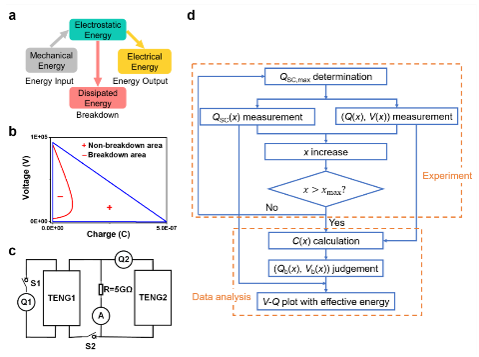A Universal Standardized Method for Output Capability Assessment of Nanogenerators
Prof. ZI Yunlong
Department of Mechanical and Automation Engineering
- It has been demonstrated that with traditional approaches, only a small portion of the maximized energy per cycle Em can be outputted, which cannot reflect the real output capability. The current version of figure-of-merits has limitations in applications, without considering the breakdown effect that seriously affects the effective maximized energy output. Meanwhile, the method to evaluate output capability of nanogenerators is missing.
- From the Research and Markets’s report, the triboelectric nanogenerator market are expected to grow at a compound annual growth rate of 48.55% over the forecast period to reach a market size of US$134.119 million in 2025 from US$18.543 million in 2019.
- A standardized universal method is proposed to evaluate the output performance of nanogenerators for the first time, and the measurement circuit is developed with operation process descripted in detail.
- Based on the proposed method, the Q-V plot of breakdown points is first derived, and the characteristic of breakdown point is then summarized, providing the method to judge the existence of breakdown in nanogenerators through its output.
- Based on the proposed method, breakdown effect in TENG with any structures can be measured and evaluated by experiments.
- In the former studies, the Eem have only been theoretical defined, and there is no way to evaluate in practical condition, but our innovation demonstrates that the cycle with the Eem can be measured experimentally for TENG.
- High output performance TENG by enhancing the air breakdown limit through high pressure atmosphere
- Extremely high output TENG based on the air breakdown effect
- Direct current TENG based on the air breakdown effect
- TENG-based wireless signal transmission based on the easy breakdown structure
- TENG-based gas sensor through the breakdown signals
- Power enhancement and management system with consideration of the air breakdown effect

Introduction of the method. (a) Energy flow chart of TENG system. (b) The V-Q plot at σ=50μC m^(-2), showing the positive (“+”) part as the non-breakdown area and negative (“-”) part as the breakdown area. (c) Circuit of the universal method, with TENG2 being the power source and TENG1 being the target device. (d) Process flow chart of the universal method.

Output characteristic of breakdown for a CS mode TENG. Q-V plots of CS mode for (a) no breakdown; (b) breakdown with spark; (c) breakdown without spark. Inset plots with lines in blue in (a-c) are the transfer charge results. Target points by green arrows in (b) and (c) are breakdown points. The inset picture of (b) is the photo of a visible spark at x = 2mm.

Measured FOM of different structures. The measured (a) structural FOM; (b) material FOM and (c) performance FOM of different structures.
A Universal Standardized Method for Output Capability Assessment of Nanogenerators
Prof. ZI Yunlong
Department of Mechanical and Automation Engineering
- It has been demonstrated that with traditional approaches, only a small portion of the maximized energy per cycle Em can be outputted, which cannot reflect the real output capability. The current version of figure-of-merits has limitations in applications, without considering the breakdown effect that seriously affects the effective maximized energy output. Meanwhile, the method to evaluate output capability of nanogenerators is missing.
- From the Research and Markets’s report, the triboelectric nanogenerator market are expected to grow at a compound annual growth rate of 48.55% over the forecast period to reach a market size of US$134.119 million in 2025 from US$18.543 million in 2019.
- A standardized universal method is proposed to evaluate the output performance of nanogenerators for the first time, and the measurement circuit is developed with operation process descripted in detail.
- Based on the proposed method, the Q-V plot of breakdown points is first derived, and the characteristic of breakdown point is then summarized, providing the method to judge the existence of breakdown in nanogenerators through its output.
- Based on the proposed method, breakdown effect in TENG with any structures can be measured and evaluated by experiments.
- In the former studies, the Eem have only been theoretical defined, and there is no way to evaluate in practical condition, but our innovation demonstrates that the cycle with the Eem can be measured experimentally for TENG.
- High output performance TENG by enhancing the air breakdown limit through high pressure atmosphere
- Extremely high output TENG based on the air breakdown effect
- Direct current TENG based on the air breakdown effect
- TENG-based wireless signal transmission based on the easy breakdown structure
- TENG-based gas sensor through the breakdown signals
- Power enhancement and management system with consideration of the air breakdown effect

Introduction of the method. (a) Energy flow chart of TENG system. (b) The V-Q plot at σ=50μC m^(-2), showing the positive (“+”) part as the non-breakdown area and negative (“-”) part as the breakdown area. (c) Circuit of the universal method, with TENG2 being the power source and TENG1 being the target device. (d) Process flow chart of the universal method.

Output characteristic of breakdown for a CS mode TENG. Q-V plots of CS mode for (a) no breakdown; (b) breakdown with spark; (c) breakdown without spark. Inset plots with lines in blue in (a-c) are the transfer charge results. Target points by green arrows in (b) and (c) are breakdown points. The inset picture of (b) is the photo of a visible spark at x = 2mm.

Measured FOM of different structures. The measured (a) structural FOM; (b) material FOM and (c) performance FOM of different structures.
Energy & Green Technology
P-2019-0896